What A Carve Up!: How an all-star lockdown hit is redefining theatre
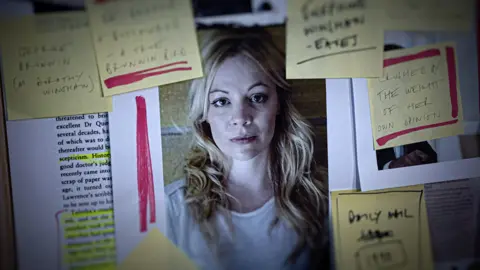 LBT/Barn/New Wolsey
LBT/Barn/New WolseyBefore the pandemic, theatres in Huddersfield, Ipswich or Cirencester would not have dreamed of casting stars like Stephen Fry or Sir Derek Jacobi, or getting glowing reviews in the New York Times.
But streaming has levelled the playing field and changed what a theatre show can be.
The day Huddersfield's Lawrence Batley Theatre (LBT) closed for the first lockdown in March, the venue's management held a crisis meeting. They had enough money to pay salaries for one more month.
They decided they "weren't going to stop creating work", though. "If we were going to go down, we were going to go down in a blaze of creative glory," says artistic director and chief executive Henry Filloux-Bennett.
In truth his 450-seat venue, in a former Methodist chapel, has always been mainly a stop-off for mid-scale touring productions, rather than a hothouse for home-grown shows.
 LBT/Barn/New Wolsey
LBT/Barn/New WolseyBut like many theatres, when the pandemic began, it decided to shift its focus to streaming.
Eight months on, it has been more successful than most and recently released an innovative, star-studded and lucrative online production that was made on a shoestring budget.
The adaptation of Jonathan Coe's 1994 novel What A Carve Up! features Fry, Jacobi, Alfred Enoch, Rebecca Front, Celia Imrie and Griff Rhys Jones.
It's a cast Filloux-Bennett could never have assembled for a real-life run in West Yorkshire. Yet they were up for an online version - which, for most, involved recording their lines at home.
Before that, Filloux-Bennett's adaption of cookery writer Nigel Slater's memoir Toast was streamed.
So was his version of David Nicholls' novel The Understudy, which starred Fry, Mina Anwar, Emily Atack and Russell Tovey.
Those two were essentially radio plays with animations adding "a nice backdrop to every scene".
The Understudy raised funds for three theatre charities and will be performed live in the West End with a cast including Fry and James Norton for two nights in December, assuming the English lockdown isn't extended.
Fry was the last to come on board for the online original, after Filloux-Bennett decided to pitch it to his agent days before they were due to announce the line-up.
"We'd had such success with the rest of the casting. I just Googled who Stephen Fry's agent was," he says.
Within two hours, the actor had signed up. "He has just been the most extraordinarily generous person with his time," says Filloux-Bennett.
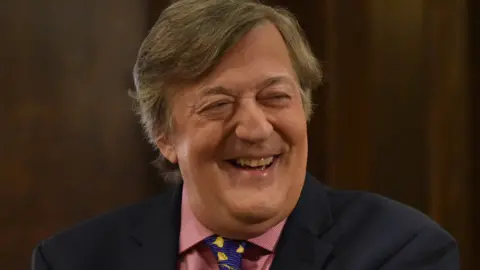
Fry then returned to provide the voice of publisher Patrick Mills in What A Carve Up!. "We assumed we'd have one bite of the Fry cherry," Filloux-Bennett says. "But I sent it over to him and he came back again almost immediately and said, 'Of course.' He's been amazing."
What A Carve Up! goes a step further with the visuals - Harry Potter and How to Get Away with Murder actor Enoch is seen on screen. So is Tamzin Outhwaite, playing an Emily Maitlis-style interviewer grilling a Paris Hilton-meets-Katie Hopkins character played by Fiona Button.
The other actors' voiceovers are overlaid with a collage of animations, graphics and archive footage, cleverly coming together to relay Coe's combination of murder mystery and scathing social satire. It's a co-production between the LBT, the Barn in Cirencester and the New Wolsey in Ipswich and is directed by Tamara Harvey of Theatr Clwyd in Mold, north Wales.
The result is "murderously enjoyable" according to the Daily Telegraph's five-star review, "ingenious and gripping" according to the Guardian, and "a dizzying, inventive adaptation" according to the i newspaper.
The New York Times headline declared it "wonderful" before adding: "But Is It Theatre?"
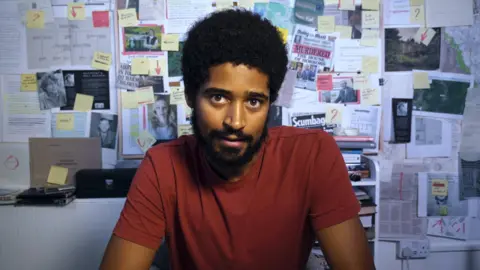 LBT/Barn/New Wolsey
LBT/Barn/New WolseyThe newspaper's critic, Alexis Soloski, said the show was "more like a true-crime podcast made fictional and visual through a series of tricky, starry YouTube videos with impressive literary pedigree".
Other reviewers also asked if the show should be described as theatre. "Maybe not," wrote Quentin Letts in the Sunday Times. But the three collaborating venues "haven't half shown up many bigger houses" with their "nimble, witty" efforts, he went on.
With live performances either difficult or impossible since March, many other agile theatre-makers have also been experimenting with recorded audio and video works that blur the traditional boundaries. And now the "bigger houses" are catching up.
'Breaking new ground'
The National Theatre is turning one of its stages into a film set for a screen version of Romeo and Juliet starring Jessie Buckley and Josh O'Connor. Artistic director Rufus Norris told the Guardian it was "very much a new form that we're discovering by the day" and that it was "great to be breaking a bit of new ground".
The question of whether such projects qualify as theatre bemuses Filloux-Bennett. "We're baffled by that need to pigeonhole stuff quite that much," he says.
"The way I see it, our job is to tell stories. That's what you do in theatre. And we're just telling a story in a different medium because that's the only medium available to us at the moment. Is it theatre? Not probably in the definition of most people's understanding. But we didn't say it was."
What A Carve Up! is "definitely not a film" either, he adds. "It's more like its own thing, and that's what we've been really excited about - creating something which is slightly not theatre, slightly not film, slightly not a radio play, slightly not really anything."
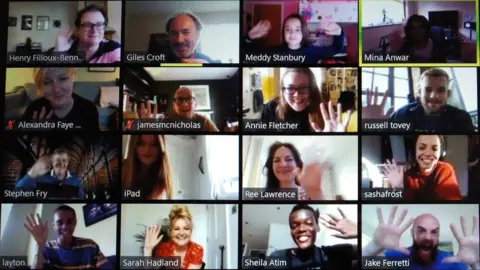 Lawrence Batley Theatre
Lawrence Batley TheatreWith a budget just over £15,000 and a two-month turnaround from starting the script to finishing the edit, it's certainly much cheaper and quicker than film or TV. "That's what this situation has shown," says Filloux-Bennett. "When you collaborate with amazing people, and you don't have much time or money, you can still create a pretty decent thing."
Standard tickets cost £12 and the show earned more than £40,000 in its first week, giving the LBT and its two sister theatres a welcome financial fillip.
With funding from Arts Council England and Kirklees Council plus almost £250,000 from the government's Culture Recovery Fund, Filloux-Bennett says his venue has avoided having to lay off any of its 35 staff, has continued paying its 60 to 70 casual employees, and can stay afloat "easily through to the next financial year".
In the future, Filloux-Bennett believes streaming and real-life shows can go hand-in-hand. "We've managed to make as much as we can of a really terrible situation, and that has been to the benefit of our reputation as a theatre," he says.
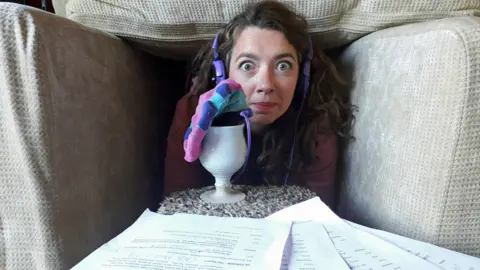 Lizzie Muncey
Lizzie MunceyThe past eight months have also made him rethink the role of a regional theatre.
The schedule of touring productions may not return until 2022 or 2023, he thinks, so his venue will make more shows - live and online - with and for the local community. "We're just going to have to be responsive and be quite scrappy and ambitious in terms of creating our own work," he says.
Smaller theatres have shown themselves to be more adaptable in a crisis than major venues, he says.
"The thing that lockdown has shown is that the bigger you are, the slower you are able to respond to stuff, and I think that is a really valuable lesson for a lot of places.
"Because we can be a bit more fleet of foot, we're the ones who have shown what we can do."
What A Carve Up! is available to stream until 29 November. The Understudy is due to be performed in a semi-staged rehearsed reading at the Palace Theatre in London on 7 and 8 December.

Follow us on Facebook, or on Twitter @BBCNewsEnts. If you have a story suggestion email [email protected].
